2014 MERCEDES-BENZ GL oil level
[x] Cancel search: oil levelPage 6 of 462
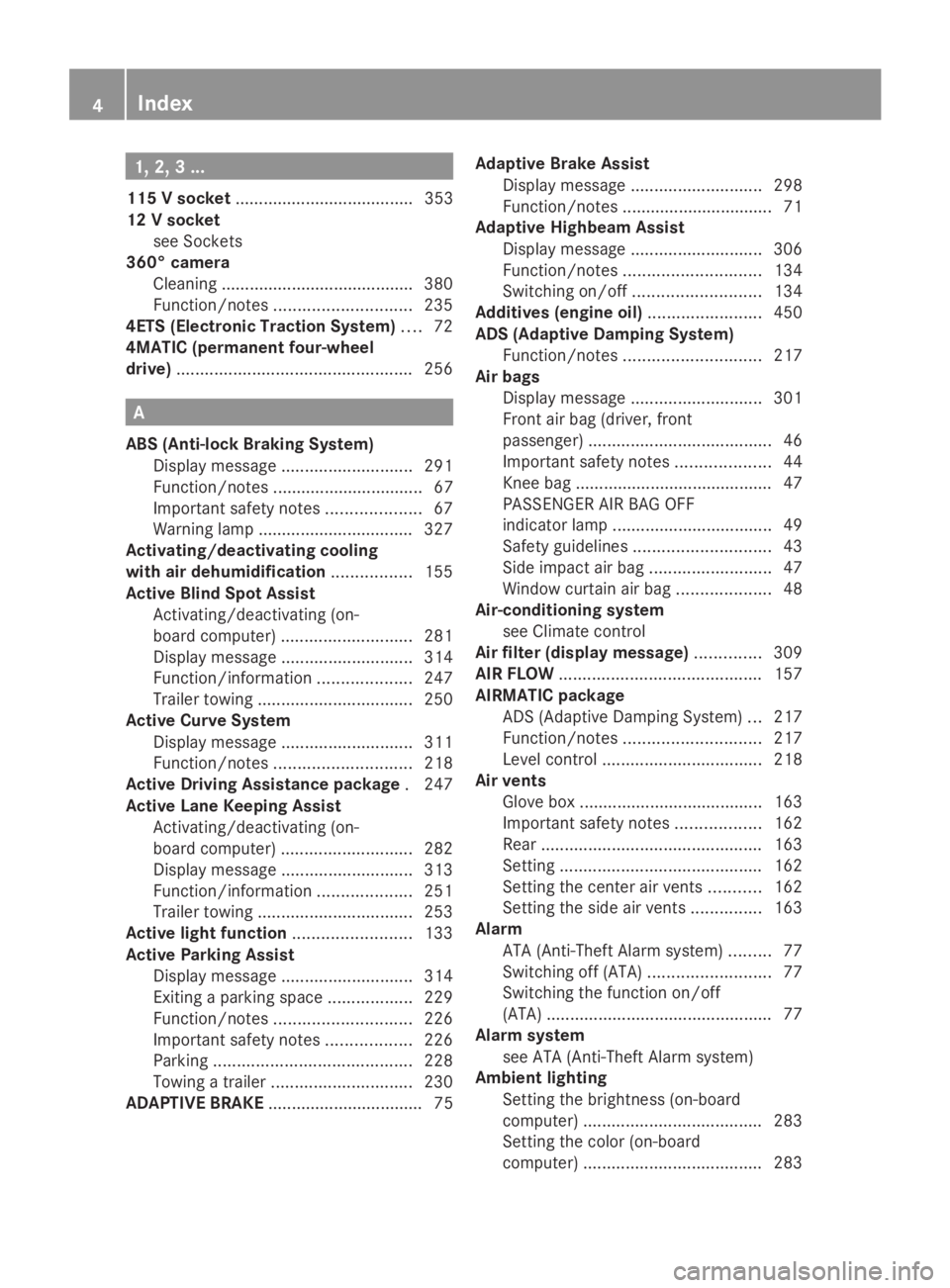
1, 2, 3 ...
115 V socket...................................... 353
12 V socket
see Sockets
360° camera
Cleaning .........................................380
Function/notes.............................235
4ETS (Electronic Traction System)....72
4MATIC (permanent four-wheel
drive)..................................................256
A
ABS (Anti-lock Braking System)
Display message............................291
Function/notes ................................ 67
Important safety notes....................67
Warning lamp ................................. 327
Activating/deactivating cooling
with air dehumidification.................155
Active Blind Spot Assist
Activating/deactivating (on-
board computer)............................281
Display message............................314
Function/information....................247
Trailer towing.................................250
Active Curve System
Display message............................311
Function/notes.............................218
Active Driving Assistance package.247
Active Lane Keeping Assist
Activating/deactivating (on-
board computer)............................282
Display message............................313
Function/information....................251
Trailer towing.................................253
Active light function.........................133
Active Parking Assist
Display message............................314
Exiting a parking space..................229
Function/notes.............................226
Important safety notes..................226
Parking..........................................228
Towing a trailer..............................230
ADAPTIVE BRAKE................................. 75
Adaptive Brake Assist
Display message............................298
Function/notes ................................ 71
Adaptive Highbeam Assist
Display message............................306
Function/notes.............................134
Switching on/off...........................134
Additives (engine oil)........................450
ADS (Adaptive Damping System)
Function/notes.............................217
Air bags
Display message............................301
Front air bag (driver, front
passenger).......................................46
Important safety notes....................44
Knee bag .......................................... 47
PASSENGER AIR BAG OFF
indicator lamp..................................49
Safety guidelines.............................43
Side impact air bag..........................47
Window curtain air bag....................48
Air-conditioning system
see Climate control
Air filter (display message)..............309
AIR FLOW...........................................157
AIRMATIC package
ADS (Adaptive Damping System)...217
Function/notes.............................217
Level control..................................218
Air vents
Glove box .......................................163
Important safety notes..................162
Rear...............................................163
Setting...........................................162
Setting the center air vents...........162
Setting the side air vents...............163
Alarm
ATA (Anti-Theft Alarm system).........77
Switching off (ATA)..........................77
Switching the function on/off
(ATA)................................................77
Alarm system
see ATA (Anti-Theft Alarm system)
Ambient lighting
Setting the brightness (on-board
computer)......................................283
Setting the color (on-board
computer)......................................283
4Index
Page 12 of 462
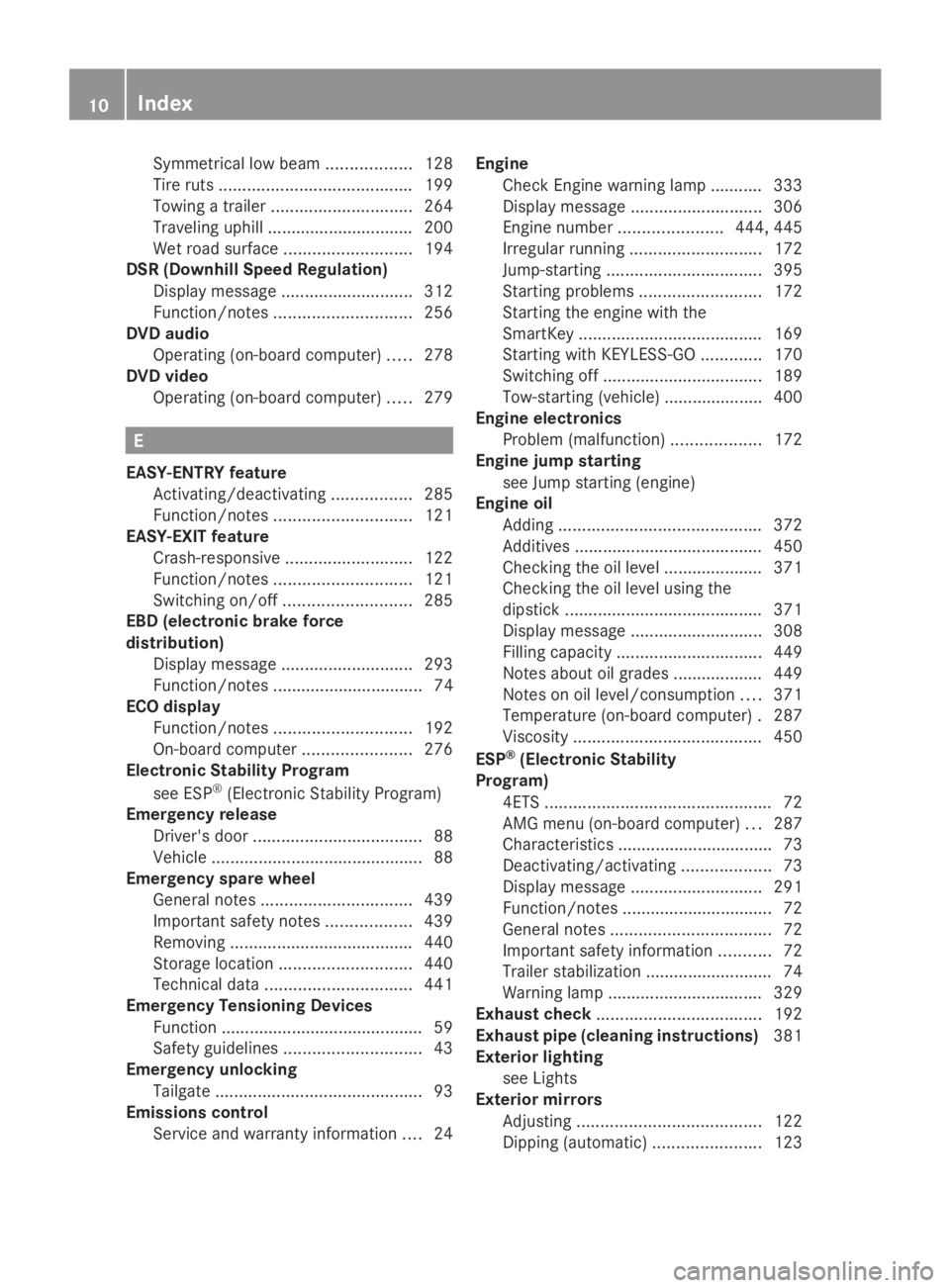
Symmetrical low beam..................128
Tire ruts.........................................199
Towing a trailer..............................264
Traveling uphill ............................... 200
Wet road surface...........................194
DSR (Downhill Speed Regulation)
Display message............................312
Function/notes.............................256
DVD audio
Operating (on-board computer).....278
DVD video
Operating (on-board computer).....279
E
EASY-ENTRY feature
Activating/deactivating.................285
Function/notes.............................121
EASY-EXIT feature
Crash-responsive...........................122
Function/notes.............................121
Switching on/off...........................285
EBD (electronic brake force
distribution)
Display message............................293
Function/notes ................................ 74
ECO display
Function/notes.............................192
On-board computer.......................276
Electronic Stability Program
see ESP®(Electronic Stability Program)
Emergency release
Driver's door....................................88
Vehicle.............................................88
Emergency spare wheel
General notes................................439
Important safety notes..................439
Removing.......................................440
Storage location............................440
Technical data...............................441
Emergency Tensioning Devices
Function ...........................................59
Safety guidelines.............................43
Emergency unlocking
Tailgate............................................93
Emissions control
Service and warranty information....24
Engine
Check Engine warning lamp ........... 333
Display message............................306
Engine number......................444, 445
Irregular running............................172
Jump-starting.................................395
Starting problems..........................172
Starting the engine with the
SmartKey.......................................169
Starting with KEYLESS-GO.............170
Switching off..................................189
Tow-starting (vehicle) ..................... 400
Engine electronics
Problem (malfunction)...................172
Engine jump starting
see Jump starting (engine)
Engine oil
Adding...........................................372
Additives........................................450
Checking the oil level ..................... 371
Checking the oil level using the
dipstick..........................................371
Display message............................308
Filling capacity...............................449
Notes about oil grades ................... 449
Notes on oil level/consumption....371
Temperature (on-board computer).287
Viscosity........................................450
ESP®(Electronic Stability
Program)
4ETS................................................72
AMG menu (on-board computer)...287
Characteristics ................................. 73
Deactivating/activating...................73
Display message............................291
Function/notes ................................ 72
General notes..................................72
Important safety information...........72
Trailer stabilization ........................... 74
Warning lamp ................................. 329
Exhaust check...................................192
Exhaust pipe (cleaning instructions)381
Exterior lighting
see Lights
Exterior mirrors
Adjusting.......................................122
Dipping (automatic).......................123
10Index
Page 199 of 462
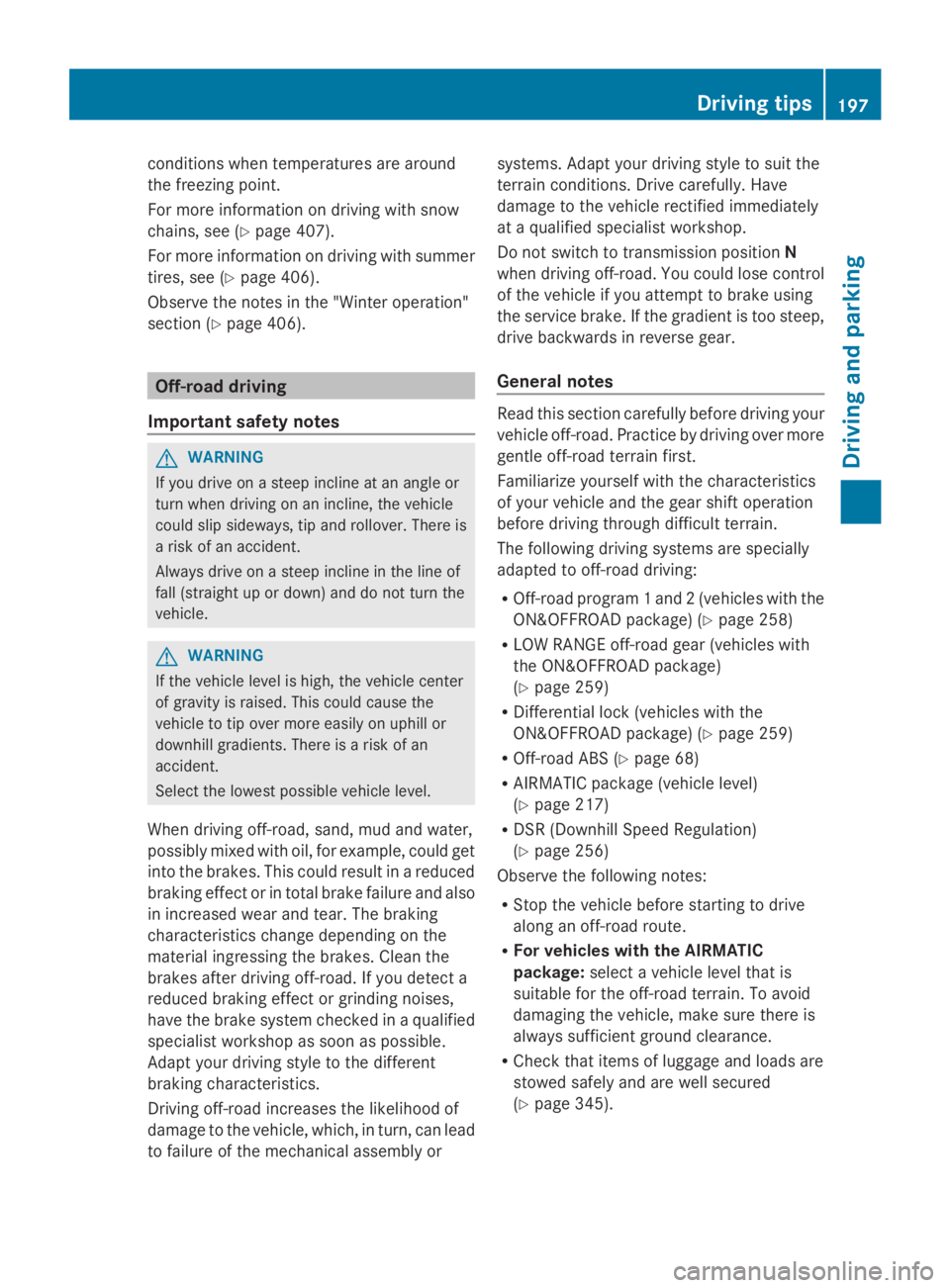
conditions when temperatures are around
the freezing point.
For more information on driving with snow
chains, see (Ypage 407).
For more information on driving with summer
tires, see (Ypage 406).
Observe the notes in the "Winter operation"
section (Ypage 406).
Off-road driving
Important safety notes
GWARNING
If you drive on a steep incline at an angle or
turn when driving on an incline, the vehicle
could slip sideways, tip and rollover. There is
a risk of an accident.
Always drive on a steep incline in the line of
fall (straight up or down) and do not turn the
vehicle.
GWARNING
If the vehicle level is high, the vehicle center
of gravity is raised. This could cause the
vehicle to tip over more easily on uphill or
downhill gradients. There is a risk of an
accident.
Select the lowest possible vehicle level.
When driving off-road, sand, mud and water,
possibly mixed with oil, for example, could get
into the brakes. This could result in a reduced
braking effect or in total brake failure and also
in increased wear and tear. The braking
characteristics change depending on the
material ingressing the brakes. Clean the
brakes after driving off-road. If you detect a
reduced braking effect or grinding noises,
have the brake system checked in a qualified
specialist workshop as soon as possible.
Adapt your driving style to the different
braking characteristics.
Driving off-road increases the likelihood of
damage to the vehicle, which, in turn, can lead
to failure of the mechanical assembly or
systems. Adapt your driving style to suit the
terrain conditions. Drive carefully. Have
damage to the vehicle rectified immediately
at a qualified specialist workshop.
Do not switch to transmission positionN
when driving off-road. You could lose control
of the vehicle if you attempt to brake using
the service brake. If the gradient is too steep,
drive backwards in reverse gear.
General notes
Read this section carefully before driving your
vehicle off-road. Practice by driving over more
gentle off-road terrain first.
Familiarize yourself with the characteristics
of your vehicle and the gear shift operation
before driving through difficult terrain.
The following driving systems are specially
adapted to off-road driving:
ROff-road program 1 and 2 (vehicles with the
ON&OFFROAD package) (Ypage 258)
RLOW RANGE off-road gear (vehicles with
the ON&OFFROAD package)
(Ypage 259)
RDifferential lock (vehicles with the
ON&OFFROAD package) (Ypage 259)
ROff-road ABS (Ypage 68)
RAIRMATIC package (vehicle level)
(Ypage 217)
RDSR (Downhill Speed Regulation)
(Ypage 256)
Observe the following notes:
RStop the vehicle before starting to drive
along an off-road route.
RFor vehicles with the AIRMATIC
package:select a vehicle level that is
suitable for the off-road terrain. To avoid
damaging the vehicle, make sure there is
always sufficient ground clearance.
RCheck that items of luggage and loads are
stowed safely and are well secured
(Ypage 345).
Driving tips197
Driving and parking
Z
Page 200 of 462
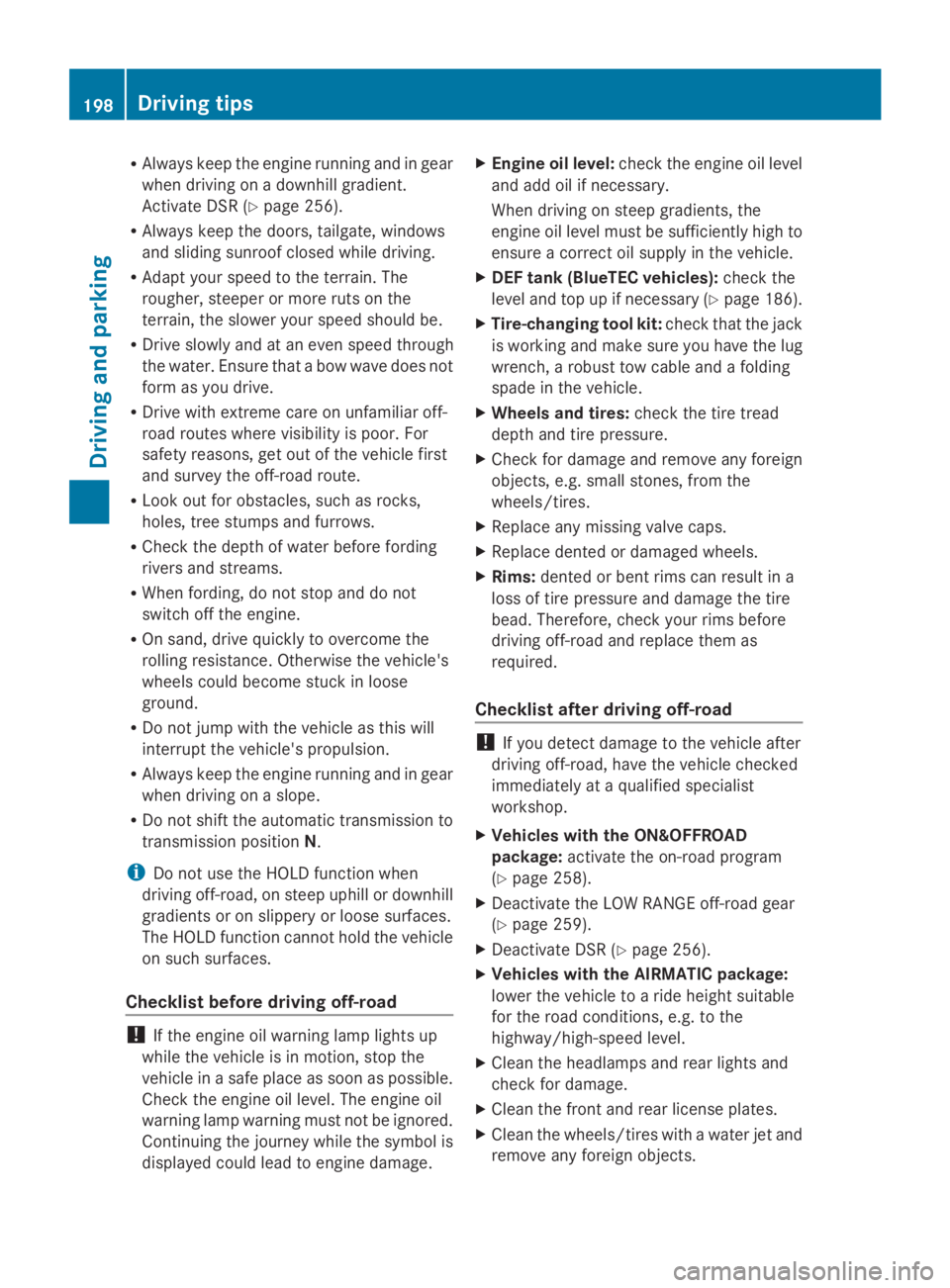
RAlways keep the engine running and in gear
when driving on a downhill gradient.
Activate DSR (Ypage 256).
RAlways keep the doors, tailgate, windows
and sliding sunroof closed while driving.
RAdapt your speed to the terrain. The
rougher, steeper or more ruts on the
terrain, the slower your speed should be.
RDrive slowly and at an even speed through
the water. Ensure that a bow wave does not
form as you drive.
RDrive with extreme care on unfamiliar off-
road routes where visibility is poor. For
safety reasons, get out of the vehicle first
and survey the off-road route.
RLook out for obstacles, such as rocks,
holes, tree stumps and furrows.
RCheck the depth of water before fording
rivers and streams.
RWhen fording, do not stop and do not
switch off the engine.
ROn sand, drive quickly to overcome the
rolling resistance. Otherwise the vehicle's
wheels could become stuck in loose
ground.
RDo not jump with the vehicle as this will
interrupt the vehicle's propulsion.
RAlways keep the engine running and in gear
when driving on a slope.
RDo not shift the automatic transmission to
transmission positionN.
iDo not use the HOLD function when
driving off-road, on steep uphill or downhill
gradients or on slippery or loose surfaces.
The HOLD function cannot hold the vehicle
on such surfaces.
Checklist before driving off-road
!If the engine oil warning lamp lights up
while the vehicle is in motion, stop the
vehicle in a safe place as soon as possible.
Check the engine oil level. The engine oil
warning lamp warning must not be ignored.
Continuing the journey while the symbol is
displayed could lead to engine damage.
XEngine oil level:check the engine oil level
and add oil if necessary.
When driving on steep gradients, the
engine oil level must be sufficiently high to
ensure a correct oil supply in the vehicle.
XDEF tank (BlueTEC vehicles):check the
level and top up if necessary (Ypage 186).
XTire-changing tool kit:check that the jack
is working and make sure you have the lug
wrench, a robust tow cable and a folding
spade in the vehicle.
XWheels and tires:check the tire tread
depth and tire pressure.
XCheck for damage and remove any foreign
objects, e.g. small stones, from the
wheels/tires.
XReplace any missing valve caps.
XReplace dented or damaged wheels.
XRims:dented or bent rims can result in a
loss of tire pressure and damage the tire
bead. Therefore, check your rims before
driving off-road and replace them as
required.
Checklist after driving off-road
!If you detect damage to the vehicle after
driving off-road, have the vehicle checked
immediately at a qualified specialist
workshop.
XVehicles with the ON&OFFROAD
package:activate the on-road program
(Ypage 258).
XDeactivate the LOW RANGE off-road gear
(Ypage 259).
XDeactivate DSR (Ypage 256).
XVehicles with the AIRMATIC package:
lower the vehicle to a ride height suitable
for the road conditions, e.g. to the
highway/high-speed level.
XClean the headlamps and rear lights and
check for damage.
XClean the front and rear license plates.
XClean the wheels/tires with a water jet and
remove any foreign objects.
198Driving tips
Driving an d parking
Page 365 of 462
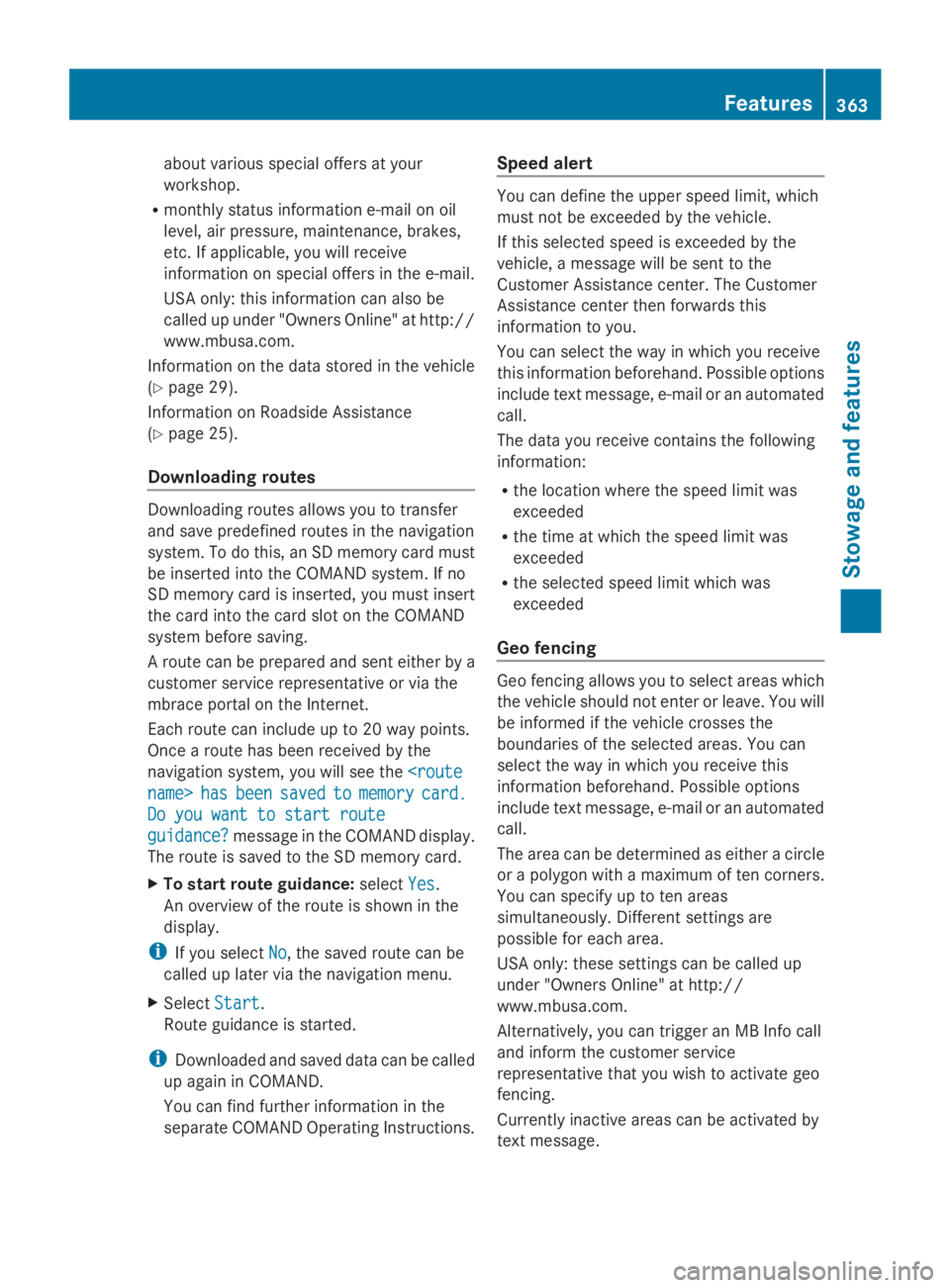
about various special offers at your
workshop.
Rmonthly status information e-mail on oil
level, air pressure, maintenance, brakes,
etc. If applicable, you will receive
information on special offers in the e-mail.
USA only: this information can also be
called up under "Owners Online" at http://
www.mbusa.com.
Information on the data stored in the vehicle
(Ypage 29).
Information on Roadside Assistance
(Ypage 25).
Downloading routes
Downloading routes allows you to transfer
and save predefined routes in the navigation
system. To do this, an SD memory card must
be inserted into the COMAND system. If no
SD memory card is inserted, you must insert
the card into the card slot on the COMAND
system before saving.
A route can be prepared and sent either by a
customer service representative or via the
mbrace portal on the Internet.
Each route can include up to 20 way points.
Once a route has been received by the
navigation system, you will see the
Do you want to start routeDo you want to start route
guidance?guidance?message in the COMAND display.
The route is saved to the SD memory card.
XTo start route guidance:selectYesYes.
An overview of the route is shown in the
display.
iIf you selectNoNo, the saved route can be
called up later via the navigation menu.
XSelectStartStart.
Route guidance is started.
iDownloaded and saved data can be called
up again in COMAND.
You can find further information in the
separate COMAND Operating Instructions.
Speed alert
You can define the upper speed limit, which
must not be exceeded by the vehicle.
If this selected speed is exceeded by the
vehicle, a message will be sent to the
Customer Assistance center. The Customer
Assistance center then forwards this
information to you.
You can select the way in which you receive
this information beforehand. Possible options
include text message, e-mail or an automated
call.
The data you receive contains the following
information:
Rthe location where the speed limit was
exceeded
Rthe time at which the speed limit was
exceeded
Rthe selected speed limit which was
exceeded
Geo fencing
Geo fencing allows you to select areas which
the vehicle should not enter or leave. You will
be informed if the vehicle crosses the
boundaries of the selected areas. You can
select the way in which you receive this
information beforehand. Possible options
include text message, e-mail or an automated
call.
The area can be determined as either a circle
or a polygon with a maximum of ten corners.
You can specify up to ten areas
simultaneously. Different settings are
possible for each area.
USA only: these settings can be called up
under "Owners Online" at http://
www.mbusa.com.
Alternatively, you can trigger an MB Info call
and inform the customer service
representative that you wish to activate geo
fencing.
Currently inactive areas can be activated by
text message.
Features363
Stowage and features
Z
Page 373 of 462

!Make sure that the windshield wipers are
not folded away from the windshield. You
could otherwise damage the windshield
wipers or the hood.
XMake sure that the windshield wipers are
turned off.
XPull release lever�Con the hood.
The hood is released.
XReach into the gap, pull hood catch
handle�Dup and lift the hood.
If you lift the hood by approximately 15 in
(40 cm), the hood is opened and held open
automatically by the gas-filled strut.
Closing the hood
XLower the hood and let it fall from a height
of approximately 8 in (20 cm).
XCheck that the hood has engaged properly.
If the hood can be raised slightly, it is not
properly engaged. Open it again and close
it with a little more force.
Radiator
Vehicles with a diesel engine:do not cover
the radiator, for example with a winter front
or bug cover. The readings of the on-board-
diagnostic system may otherwise be
inaccurate. Some of these readings are
required by law and must be accurate at all
times.
Engine oil
General notes
Depending on your driving style, the vehicle
consumes up to 0.9 US qt (0.8 liters) of oil per
600 miles (1,000 km). The oil consumption
may be higher than this when the vehicle is
new or if you frequently drive at high engine
speeds.
Depending on the engine, the oil dipstick may
be in a different location.
When checking the oil level:
Rpark the vehicle on a level surface.
Rthe engine should be switched off for
approximately five minutes if the engine is
at normal operating temperature.
Rif the engine is not at normal operating
temperature, e.g. if the engine was only
started briefly, wait about 30 minutes
before carrying out the measurement.
Checking the oil level using the oil
dipstick
GWARNING
Certain components in the engine
compartment, such as the engine, radiator
and parts of the exhaust system, can become
very hot. Working in the engine compartment
poses a risk of injury.
Where possible, let the engine cool down and
touch only the components described in the
following.
Engine compartment371
Maintenance and care
Z
Page 374 of 462
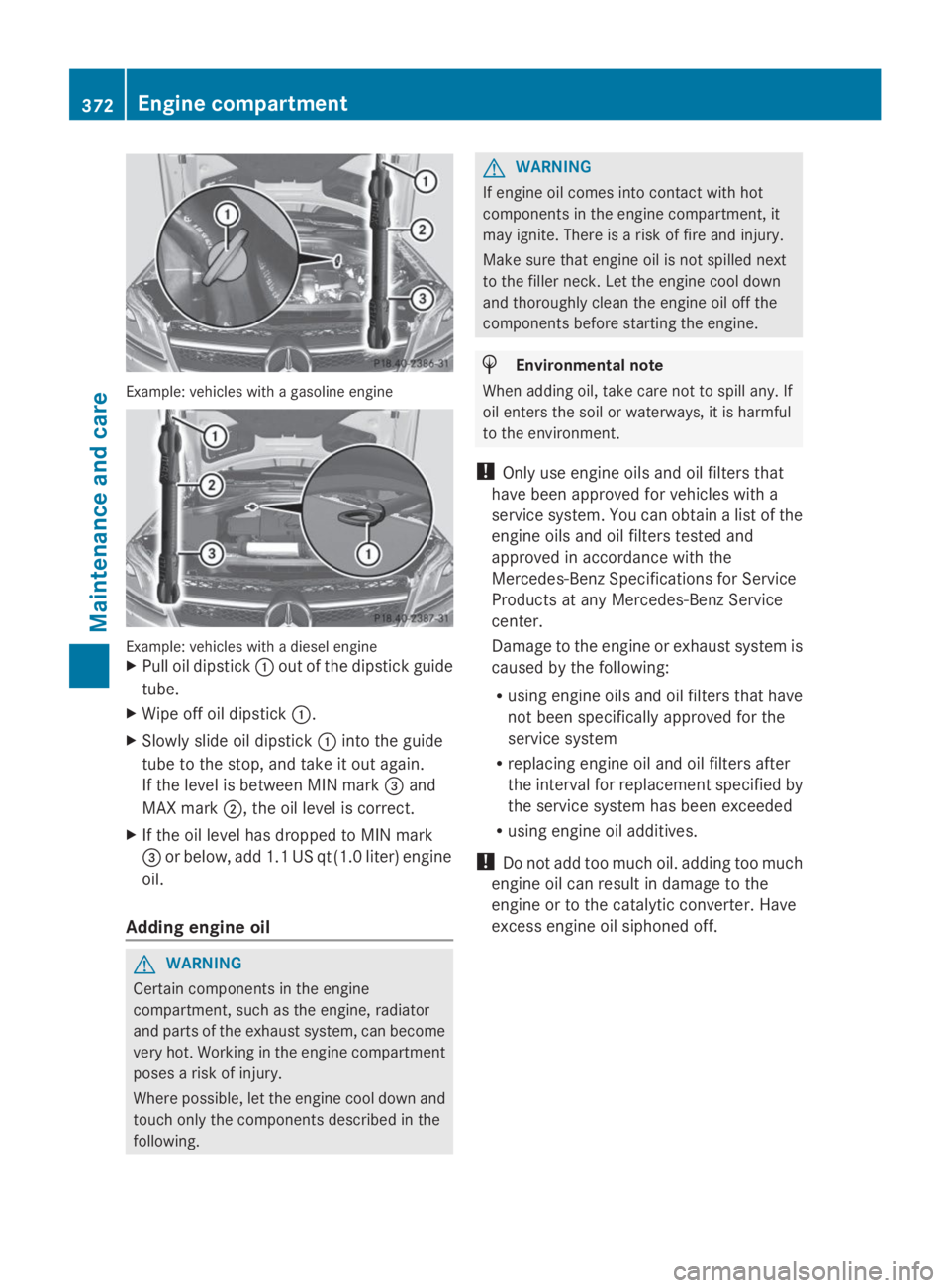
Example: vehicles with a gasoline engine
Example: vehicles with a diesel engineXPull oil dipstick�Cout of the dipstick guide
tube.
XWipe off oil dipstick�C.
XSlowly slide oil dipstick�Cinto the guide
tube to the stop, and take it out again.
If the level is between MIN mark�
Page 375 of 462
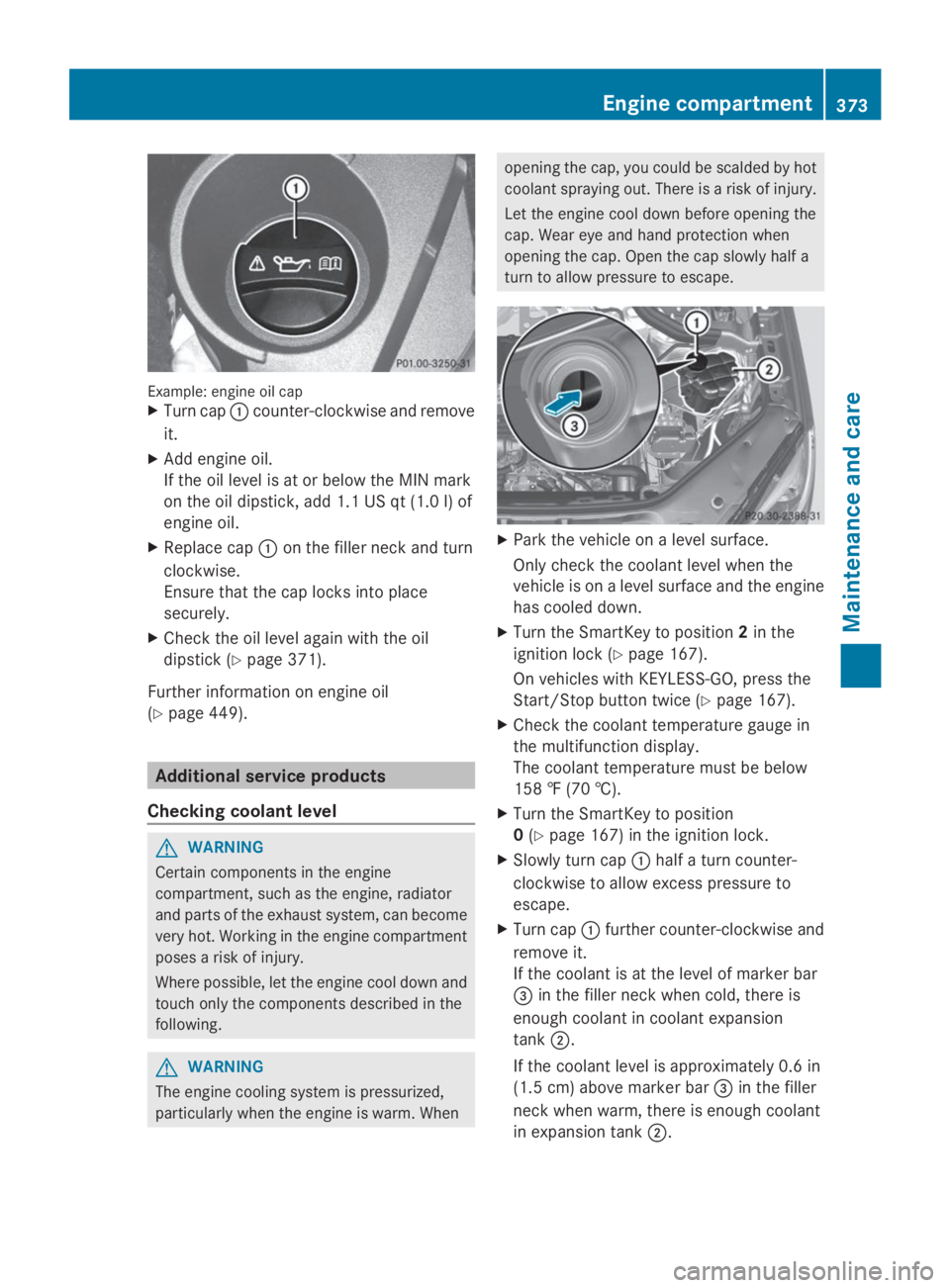
Example: engine oil capXTurn cap�Ccounter-clockwise and remove
it.
XAdd engine oil.
If the oil level is at or below the MIN mark
on the oil dipstick, add 1.1 US qt (1.0 l) of
engine oil.
XReplace cap�Con the filler neck and turn
clockwise.
Ensure that the cap locks into place
securely.
XCheck the oil level again with the oil
dipstick (Ypage 371).
Further information on engine oil
(Ypage 449).
Additional service products
Checking coolant level
GWARNING
Certain components in the engine
compartment, such as the engine, radiator
and parts of the exhaust system, can become
very hot. Working in the engine compartment
poses a risk of injury.
Where possible, let the engine cool down and
touch only the components described in the
following.
GWARNING
The engine cooling system is pressurized,
particularly when the engine is warm. When
opening the cap, you could be scalded by hot
coolant spraying out. There is a risk of injury.
Let the engine cool down before opening the
cap. Wear eye and hand protection when
opening the cap. Open the cap slowly half a
turn to allow pressure to escape.
XPark the vehicle on a level surface.
Only check the coolant level when the
vehicle is on a level surface and the engine
has cooled down.
XTurn the SmartKey to position2in the
ignition lock (Ypage 167).
On vehicles with KEYLESS-GO, press the
Start/Stop button twice (Ypage 167).
XCheck the coolant temperature gauge in
the multifunction display.
The coolant temperature must be below
158 ‡ (70 †).
XTurn the SmartKey to position
0(Ypage 167) in the ignition lock.
XSlowly turn cap�Chalf a turn counter-
clockwise to allow excess pressure to
escape.
XTurn cap�Cfurther counter-clockwise and
remove it.
If the coolant is at the level of marker bar
�